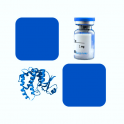
- Remove this product from my favorite's list.
- Add this product to my list of favorites.
Products
Viewed products
Newsletter
 |  |  |  |  |  |

Background
CD36 (Cluster of Differentiation 36) is also known as platelet membrane glycoprotein IV (GPIV), fatty acid translocase (FAT), thrombospondin receptor, collagen receptor, and scavenger receptor class B, member 3 (SRB3), is a member of the class B scavenger receptor family of cell surface proteins. The human CD36 gene encodes a single chain 472 amino acid residue protein containing both an N- and a C-terminal cytoplasmic tail and an extracellular loop.CD36 is found on platelets, erythrocytes, monocytes, differentiated adipocytes, mammary epithelial cells, spleen cells and some skin microdermal endothelial cells. CD36 is a multiligand pattern recognition receptor that interacts with a large number of structurally dissimilar ligands, including long chain fatty acid (LCFA), advanced glycation end products (AGE), thrombospondin-1, oxidized low-density lipoproteins (oxLDLs), high density lipoprotein (HDL), phosphatidylserine, apoptotic cells, beta-amyloid fibrils (fAβ), collagens I and IV, and Plasmodium falciparum infected erythrocytes. CD36 is required for the anti-angiogenic effects of thrombospondin1 In the corneal neovascularization assay. On binding a ligand the protein and ligand are internalized. This internalization is independent of macropinocytosis and occurs by an actin dependent mechanism requiring the activation Src-family kinases, JNK and Rho-family GTPases. CD36 ligands have also been shown to promote sterile inflammation through assembly of a Toll-like receptor 4 and 6 heterodimer.
Source
Recombinant Human CD36 / SR-B3 Protein, His Tag (CD6-H5221) is expressed from human 293 cells (HEK293). It contains AA Gly 30 - Asn 439 (Accession # NP_001001547.1).
Predicted N-terminus: Gly 30
Molecular Characterization
This protein carries a polyhistidine tag at the C-terminus.
The protein has a calculated MW of 48.5 kDa. The protein migrates as 66-80 kDa under reducing (R) condition (SDS-PAGE) due to glycosylation.
Endotoxin
Less than 1.0 EU per μg by the LAL method.
Purity
>95% as determined by SDS-PAGE.
>90% as determined by SEC-MALS.
Formulation
Lyophilized from 0.22 μm filtered solution in PBS, pH7.4 with trehalose as protectant.
Reconstitution
Please see Certificate of Analysis for specific instructions.
For best performance, we strongly recommend you to follow the reconstitution protocol provided in the CoA.
Storage
For long term storage, the product should be stored at lyophilized state at -20°C or lower.
Please avoid repeated freeze-thaw cycles.
This product is stable after storage at:
-20°C to -70°C for 12 months in lyophilized state;
-70°C for 3 months under sterile conditions after reconstitution.
Bioacticity
Please refer to product data sheet.
(1) "Identification and validation of oxidative stress-related genes in sepsis-induced myopathy"
Zhang, Huang, Li et al
Medicine (Baltimore) (2024) 103 (18), e37933
(2) "Inhibition of fatty acid uptake by TGR5 prevents diabetic cardiomyopathy"
Wang, Wang, Cui et al
Nat Metab (2024)
(3) "Infection of Human Macrophage-Like Cells by African Swine Fever Virus"
Karalyan, Ghonyan, Poghosyan et al
Front Biosci (Landmark Ed) (2024) 29 (4), 164
Showing 1-3 of 8497 papers.
Follow us